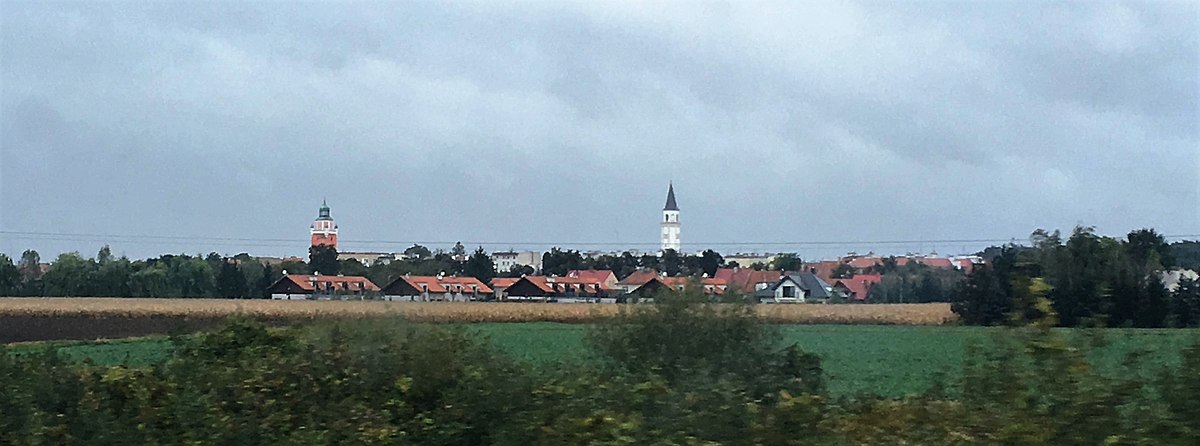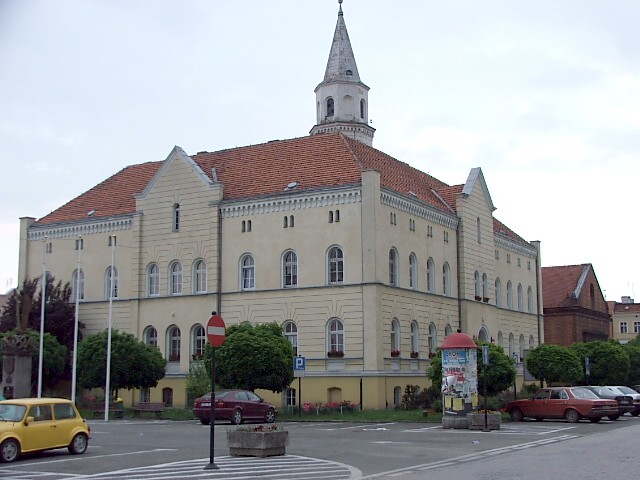Kąty Wrocławskie

Kąty Wrocławskie. – Photo by: Bjoertvedt, Katy Wroclawskie IMG 5121, CC BY-SA 4.0
Distance
Population
5.495 (2005)
Location and history
Kąty Wrocławskie is located in Lower Silesia, on the Bystrzyca River, just north of the E40 motorway between the German border and Katowice – Kraków. The distance to the northeast to the regional capital Wrocław’s center is only 24 km.
City Name: The name was previously spelled Kant or Kanth, a word that undoubtedly derives from the Slavic word “cat”, probably in the sense in which the word “cat” or “kut” used for settlements, built in wooded areas. But other explanations are also possible. In the present, the place name is used in the Polish and plural form: Kąty. Ca. 50 Polish localities are now called Kąty, which is why the city name Wrocław has been added as a clarifying descendant.
Already in the 12th century a wooden church is mentioned, dedicated to Saint Peter and Paul in the fortified city of Kant. In a document from 1293, Kant is mentioned as a castle. In October 1297, Kant was granted market rights by Prince Bolko I of idwidnica and in an October 1298 document, the same prince confirmed those rights.
The town and castle were thus owned first by the prince of Świdnica, then by the prince of Jawor, and in 1337 they were given a mortgage on the Czech king. Then the town belonged to the prince of Ziębice, then the prince of Oleśnica and from 1474 it belonged to the chapter in Wrocław.
In 1526, Silesia came under Austrian rule.
In the late 16th century, the city wall was expanded and renovated; At the same time, a gallows – mostly in brick – was erected near the city wall. In 1613, a “the city tower”, later called the Town Hall Tower. In 1624, a fierce fire ensued, destroying, among other things. the town hall and about 165 houses in the city as well as even the castle that was outside the city. The very extensive and devastating fire had arisen in a distillery. The owner of this distillery and his family have since been chased out of town.
In the 1600s, the city also suffered from acts of war (looting by army forces), epidemics and probably a fire.
In the fall of 1745, the Prussian king, Friedrich II, assumed power in Silesia. In 1813, Russian forces were housed in Kąty in connection with the war against Napoleon. In the battle of the Kaczawa River (east of Złotoryja) on 26.8.1813, the Prussian-Russian forces prevailed over Napoleon's army.
In 1825, the city numbered 1285 inhabitants, including 133 evangelical believers and 3 Jews. On January 2, 1848, the first public meeting of the City Council took place. The construction of a new town hall was begun in 1876 and completed in 1879. In 1890, the number of inhabitants increased to 2785, of which 1035 were evangelical believers and 11 Jews.
In 1922 a memorial was erected in the square for the townspeople who fell in the war 1914-1918.
At the end of World War II, part of the German population in the city was evacuated to the west – along with many of the German inhabitants of Wrocław, whose itinerary passed through Kąty. The city was liberated on 11 February by Soviet forces. In the fall of 1945, the Soviet army left Kąty and left the regime to the Polish authorities.

Town hall on the square in Kąty Wrocławskie
Tourist attractions
St. Peter and Paul's Church
- the parish church in Kąty, was erected in the first quarter of the 15th century. at the site of a former church. This Gothic slate church was built around 1520. The tower has a square floor plan, but has an octagonal finish at the top. The upper part of the tower, including the helmet, dates from the renovation in 1825-27. The church room is divided into 3 ships using octagonal pillars bearing the star vaults. At the southeast corner of the tower a staircase is provided. In the south wall a stone portal leads from approx. 1500 into the porch. Church equipment ranges in time from the Gothic in the 15th century. to neo-Gothic elements from 1890’s. The oldest artwork is a sculpture in wood by Madonna with the child from 1410.
The northern part of the cemetery wall is a remnant of the city wall, which was erected in the first half of the 14th century.
Surrounding Area
Kamionna (5 km s of Katy). – The castle of Kamionna, ie. the ruins of the castle, located in a park in the eastern part of the village and formerly belonged to the genus von Zedlitz. The castle was once surrounded by a water-filled moat. The original manor on the site dates from the 16th century. The later Baroque castle was erected in 1740-44.
Krobielowice (3 km lake for Katy). – The castle in Krobielowice is located in the southwestern part of the village. In the early Middle Ages stood a fortress tower; in 1570 the construction of the castle began, initially as two wings. In 1702-1704 two more baroque-style wings were erected. In 1878 some rebuilding took place and 3 round towers were added. In 1938-39, a few remodels were carried out, among other things. the northern corner tower was removed. The present castle is thus a four-wing Renaissance and Baroque style building with archways facing an inner castle courtyard. The hotel and restaurant are now equipped with buildings.
Accommodation
Miasto in Gmina Kąty Wrocławskie – in Polish, English and German, with practical information for tourists
Eating Out:
Miasto in Gmina Kąty Wrocławskie – in Polish, English and German, with practical information for tourists
Other Internet sites and sources
Miasto in Gmina Kąty Wrocławskie – in Polish, English and German
Translated into English by Google Translate. Spangshus.dk accept no liability for any errors or omissions in translation.
Map

Rating
Search
Most used tags
churches (205) Castles (86) Monasteries (79) Town walls (74) Lakes (71) Town halls (67) Rivers (65) Castles1 (62) Mansions (55) Museums (51) Regional museums (38) Town gates (36) Abbey churches (35) Castle ruins (30) Cathedrals (26) Forests (25) Health resorts (24) Mounds (23) Water sports (23) National parks (22)Click for all tags
Denne side er også tilgængelig på dansk. This page and contents is (c) Copyright 2018- www.spangshus.dk. Based on Inviator software by ISCA Software